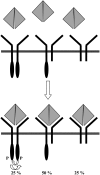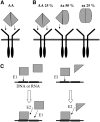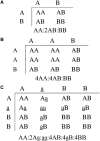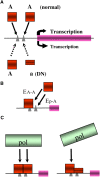Exploring the molecular etiology of dominant-negative mutations
- PMID: 18083908
- PMCID: PMC2217636
- DOI: 10.1105/tpc.107.055053
Exploring the molecular etiology of dominant-negative mutations
Figures








Similar articles
-
A dominant negative mutant of PG13 suppresses transcription from a cauliflower mosaic virus 35S truncated promoter in transgenic tobacco plants.Plant Cell. 1994 Aug;6(8):1087-98. doi: 10.1105/tpc.6.8.1087. Plant Cell. 1994. PMID: 7919980 Free PMC article.
-
When negative is positive in functional genomics.Trends Plant Sci. 2003 Jun;8(6):279-85. doi: 10.1016/S1360-1385(03)00101-8. Trends Plant Sci. 2003. PMID: 12818662 Review.
-
Epigenetic regulation of the maize Spm transposable element: novel activation of a methylated promoter by TnpA.Cell. 1994 May 6;77(3):427-37. doi: 10.1016/0092-8674(94)90157-0. Cell. 1994. PMID: 8181061
-
Genetic analysis and fine mapping of a novel semidominant dwarfing gene LB4D in rice.J Integr Plant Biol. 2011 Apr;53(4):312-23. doi: 10.1111/j.1744-7909.2011.01031.x. Epub 2011 Mar 21. J Integr Plant Biol. 2011. PMID: 21294842
-
Promoter bashing, microRNAs, and Knox genes. New insights, regulators, and targets-of-regulation in the establishment of lateral organ polarity in Arabidopsis.Plant Physiol. 2004 Jun;135(2):685-94. doi: 10.1104/pp.104.040394. Plant Physiol. 2004. PMID: 15208415 Free PMC article. Review. No abstract available.
Cited by
-
Comprehensive assessment of recessive, pathogenic AARS1 alleles in a humanized yeast model reveals loss-of-function and dominant-negative effects.bioRxiv [Preprint]. 2024 Jun 24:2024.06.20.599900. doi: 10.1101/2024.06.20.599900. bioRxiv. 2024. Update in: Dis Model Mech. 2025 Jun 1;18(6):dmm052006. doi: 10.1242/dmm.052006. PMID: 38979321 Free PMC article. Updated. Preprint.
-
Analysis of the dominant mutation N188T of human connexin46 (hCx46) using concatenation and molecular dynamics simulation.FEBS Open Bio. 2019 May;9(5):840-850. doi: 10.1002/2211-5463.12624. Epub 2019 Mar 23. FEBS Open Bio. 2019. PMID: 31034164 Free PMC article.
-
Genome Editing as a Treatment for the Most Prevalent Causative Genes of Autosomal Dominant Retinitis Pigmentosa.Int J Mol Sci. 2019 May 23;20(10):2542. doi: 10.3390/ijms20102542. Int J Mol Sci. 2019. PMID: 31126147 Free PMC article. Review.
-
Spinocerebellar ataxia 38: structure-function analysis shows ELOVL5 G230V is proteotoxic, conformationally altered and a mutational hotspot.Hum Genet. 2023 Aug;142(8):1055-1076. doi: 10.1007/s00439-023-02572-y. Epub 2023 May 18. Hum Genet. 2023. PMID: 37199746 Free PMC article.
-
Gene Therapy for Retinitis Pigmentosa: Current Challenges and New Progress.Biomolecules. 2024 Jul 25;14(8):903. doi: 10.3390/biom14080903. Biomolecules. 2024. PMID: 39199291 Free PMC article. Review.
References
-
- Barren, B., and Artemyev, N.O. (2007). Mechanisms of dominant negative G-protein alpha subunits. J. Neurosci. Res. 85 3505–3514. - PubMed
-
- Birchler, J.A., Bhadra, U., Bhadra, M.P., and Auger, D.L. (2001). Dosage-dependent gene regulation in multicellular eukaryotes: implications for dosage compensation, aneuploid syndromes, and quantitative traits. Dev. Biol. 234 275–288. - PubMed
-
- Burz, D.S., and Hanes, S.D. (2001). Isolation of mutations that disrupt cooperative DNA binding by the Drosophila bicoid protein. J. Mol. Biol. 305 219–230. - PubMed
-
- Carey, M. (1998). The enhanceosome and transcriptional synergy. Cell 92 5–8. - PubMed
Publication types
MeSH terms
Substances
LinkOut - more resources
Full Text Sources
Other Literature Sources

